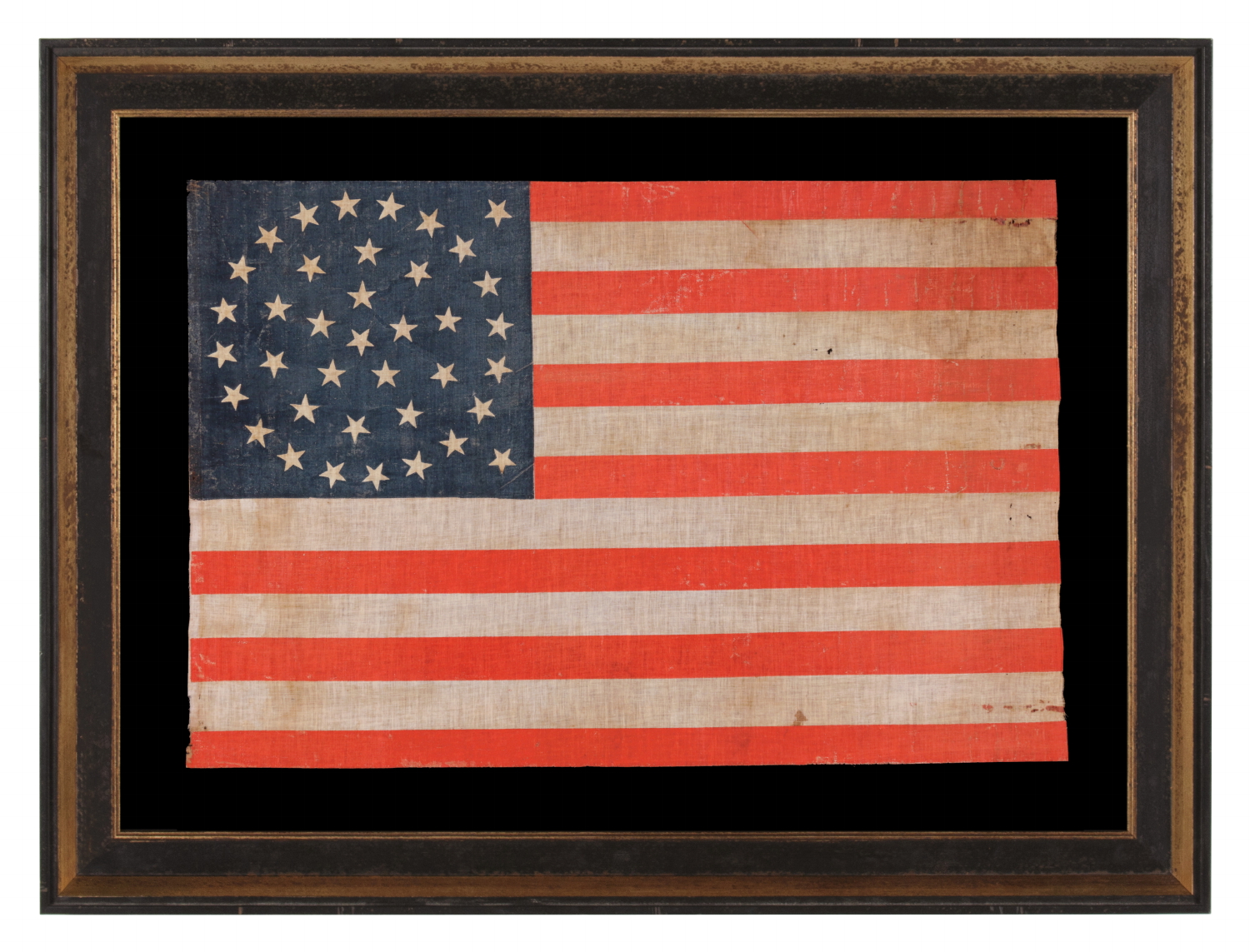
| |
38 STARS IN A TRIPLE WREATH STYLE MEDALLION CONFIGURATION, WITH 2 OUTLIERS, ON A LARGE SCALE ANTIQUE AMERICAN PARADE FLAG WITH GREAT COLORS AND PRESENCE, MADE IN THE ERA WHEN COLORADO WAS THE MOST RECENT STATE TO JOIN THE UNION, 1876-1889 |
|
| Available: |
Sold |
| Frame Size (H x L): |
Approx. 37" x 48.5" |
| Flag Size (H x L): |
23.75" x 35.5" |
|
| Description....: |
|
38 star American parade flag, block-printed by hand on coarse, glazed cotton. The stars are arranged in a triple-wreath form of the medallion configuration, with a single center star and two stars flanking outside the basic pattern toward the fly end. Most circular medallion patterns exhibit four flanking stars beyond the consecutive wreaths, one in each corner. The inclusion of only two was intentional, allowing for the easy addition of two more stars. Flag-makers knew that more Western Territories were soon to be added and eagerly anticipated their arrival. Use of fewer than four outliers was popular in 38 star parade flags, but is rarely encountered in other star counts.
Note how the square profile of the canton contributes to its interesting presentation. Most parade flags in this star count have red stripes that lean heavily toward orange, with a vibrant, chromatic luster, as-is the case here. This was common across printed flags produced between the 1850's and the 38 star period, phasing out in the last decade of the 19th century.
Colorado became the 38th state on August 1st, 1876. This was the year of our nation’s 100-year anniversary of independence. Per the Third Flag Act of 1818, stars were not officially added until the 4th of July following a state's addition. For this reason, 37 was the official star count for the American flag in 1876. Flag-making was a competitive venture, however, and few flag-makers would have been continuing to produce 37 star flags when their competitors were making 38’s. It is for this reason that 38 and 13 stars (to represent the original 13 colonies) are more often seen at the Centennial International Exposition, the six-month long World’s Fair held in Philadelphia in honor of the event. Some flag-makers would have been adding a star for the 38th state even before it entered the Union, in the early part of 1876 or even prior. In fact, many makers of parade flags were actually producing 39 star flags, in hopeful anticipation of the addition of two more Western Territories instead of one. But the 39th state would not join the Union for another 13 years, when the Dakota Territory entered as two states on the same day. The 38 star flag became official on July 4th, 1877 and was generally used until the addition of the Dakotas in 1889.
Also known as hand-wavers, most parade flags measured three feet long or less. Larger examples, such as this one, make a bold statement, especially those with dynamic star patterns.
President Ulysses S. Grant was in office when the first 38 star flags would have appeared. The list of presidents serving during the period when the 38 star flag was actually official include Rutherford B. Hayes, James Garfield, Chester Arthur, Grover Cleveland, and Benjamin Harrison.
Mounting: The flag was mounted and framed within our own conservation department, which is led by expert staff. We take great care in the mounting and preservation of flags and have framed thousands of examples; more than anyone worldwide. The flag has been hand-stitched to a background of 100% cotton twill, black in color, that was washed to remove excess dye. An acid-free agent was added to the wash to further set the dye and the fabric was heat-treated for the same purpose. The mount was then placed in a black-painted, hand-gilded and distressed Italian molding. The glazing is U.V. protective Plexiglas.
Condition: There is minor misprinting in the canton and there is modest to moderate foxing and soiling throughout the white portion of the fabric especially, the most significant of which is in the upper, fly-end quadrant. There is very minor fabric loss along the hoist end. There are tiny holes in the 2nd, 4th, and 6th stripes, toward the fly end. There are globs of the red-orange pigment on the reverse, near the fly end, in the first and last white stripes, which can be seen where the color bleed through to the front. This is an extraordinary phenomenon that I have never encountered previously on other flags with this or any other pigment type or dye, before finding it present on a small group of these particular flags. Some of the globs were carefully removed for future scientific testing. Many of my clients prefer early flags to show their age and history of use. |
|
|
|
| Collector Level: |
Advanced Collectors and the Person with Everything |
|
| Flag Type: |
Parade flag |
|
| Star Count: |
38 |
|
| Earliest Date of Origin: |
1876 |
|
| Latest Date of Origin: |
1889 |
|
| State/Affiliation: |
Colorado |
|
| War Association: |
1866-1890 Indian Wars |
|
| Price: |
SOLD |
|
| |
Views: 1318 |
|
|
|

